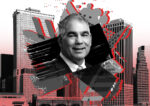M&T Bank is distancing itself from the dangers of commercial real estate, a strategy most regional lenders are aching to achieve.
In the third quarter, as the Federal Reserve made its first rate cut after a crippling cycle of increases, Buffalo-based M&T cut its share of distressed commercial real estate loans, its reserves set aside for CRE losses, and its exposure to the asset class at large.
Reducing loss reserves boosted profits — and the mood of the bank’s chief financial officer.
“We have a lot of momentum,” Daryl Bible said. “I’m very optimistic.”
Continuing that momentum, though, is tied to what the Fed does next.
Bible said lower rates allowed borrowers to pay down or pay off loans and let the bank move mortgages out of the “criticized” category — debt at risk of default.
The share of criticized loans in M&T’s CRE loan book dipped to 23.4 percent from 25.6 percent in the quarter. The bank reported a decline even as it reduced its commercial real estate exposure by 8 percent to $29.1 billion in the period.
If the Fed drops rates another 50 basis points as expected this year and 100 next year, borrowers will be in even better shape and conceivably, so will M&T’s loan book.
“It probably won’t be a direct line down,” Bible said of criticized loans. “But I think the trajectory is definitely down.”
Still, the CFO didn’t rule out a “mild recession.” Some analysts suspect the labor market is in worse shape than the numbers show — a recession risk. The Labor Department in August revised jobs numbers, revealing fewer jobs were added in 2023 and 2024 than previously reported.
That makes further rate cuts more likely because if layoffs tick up, the Fed worries less about the economy overheating and triggering inflation.
Meanwhile, the office sector remains a sore point for regional lenders.
M&T reported its share of office loans at risk of default rose to 30 percent from 27 percent in the second quarter as the bank shaved down its office exposure. M&T reported $4.41 billion outstanding office loans in the third quarter compared to $4.48 billion in the second.
The bank also cut its provision for credit losses — an estimate of what it may lose on bad debt — by $30 million quarter-over-quarter and year-over-year. The metric is marked as an expense, so the dip aided profits.
M&T reported diluted earnings of $4.02 per share compared to $3.73 in the second quarter and $3.98 a year ago. Net income jumped to $721 billion, a 10 percent increase from the previous quarter and 4.5 percent bump year-over-year.
Given projections that Fed will further cut rates, Evercore ISI analyst John Pancari asked if M&T would continue to whittle down its loss reserves.
Bible said as the bank moves away from commercial real estate lending in favor of consumer debt, which tends to come with higher losses, it may boost its reserves. Still, he highlighted M&T’s reduced exposure as aligning with its near-term strategy.
“We are really trying to be a much more diversified company, not so much reliant on CRE,” the CFO said.
Read more



